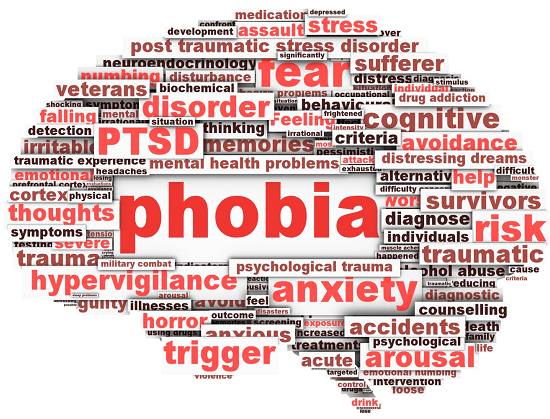Different Phobias from A-Z
Phobias are
one of the most common mental
illnesses in the United States. According to the National
Institute of Mental Health (NIH), approximately 12.5% of adults in the U.S.
will deal with a specific phobia in their lifetime.1 Women are more
likely to experience phobias than men. Typical symptoms of phobias can include
nausea, trembling, rapid heartbeat, feelings of unreality, and being
preoccupied with the fear object.
The American Psychiatric
Association (APA) identifies three different categories of phobias: social
phobias, agoraphobia, and specific phobias.2 When people talk about having a
phobia of a specific object such as snakes, spiders, or needles, they are
referring to a specific
phobia.
While not
comprehensive, this list of phobias offers a glimpse of the many phobias that
can have a serious impact on a person's life. As you may notice while you
browse through this list, most specific phobias fall into one of four major
categories:3
- Fears of the natural environment
- Fears related to animals
- Fear related to medical treatments
or issues
- Fears related to specific
situation
A
- Achluophobia: Fear of
darkness
- Acrophobia:
Fear of heights
- Aerophobia: Fear of flying
- Algophobia: Fear of pain
- Agoraphobia: Fear of open
spaces or crowds
- Aichmophobia: Fear of
needles or pointed objects
- Amaxophobia: Fear of riding
in a car
- Androphobia: Fear of men
- Anginophobia: Fear of angina
or choking
- Anthrophobia: Fear of
flowers
- Anthropophobia:
Fear of people or society
- Aphenphosmphobia: Fear of being
touched
- Arachibutyrophobia: Fear of peanut butter
- Arachnophobia:
Fear of spiders
- Arithmophobia: Fear of
numbers
- Astraphobia: Fear of
thunder and lightning
- Ataxophobia: Fear of
disorder or untidiness
- Atelophobia: Fear of
imperfection
- Atychiphobia: Fear of
failure
- Automatonophobia:
Fear of human-like figures
- Autophobia: Fear of
being alone
B
- Bacteriophobia: Fear of
bacteria
- Barophobia: Fear of
gravity
- Bathmophobia: Fear of stairs
or steep slopes
- Batrachophobia: Fear of
amphibians
- Belonephobia: Fear of pins
and needles
- Bibliophobia: Fear of books
- Botanophobia: Fear of plants
C
- Cacophobia: Fear of
ugliness
- Catagelophobia: Fear of being ridiculed
- Catoptrophobia: Fear of
mirrors
- Chionophobia: Fear of snow
- Chromophobia: Fear of colors
- Chronomentrophobia: Fear of clocks
- Chronophobia:
Fear of time
- Claustrophobia: Fear of
confined spaces
- Coulrophobia:
Fear of clowns
- Cyberphobia: Fear of
computers
- Cynophobia: Fear of dogs
D
- Dendrophobia: Fear of trees
- Dentophobia: Fear of
dentists
- Domatophobia: Fear of houses
- Dystychiphobia: Fear of
accidents
E
- Ecophobia: Fear of the home
- Elurophobia: Fear of cats
- Entomophobia: Fear of
insects
- Ephebiphobia: Fear of
teenagers
- Equinophobia: Fear of horses
G
- Gamophobia: Fear of
marriage
- Genuphobia: Fear of knees
- Glossophobia: Fear of
speaking in public
- Gynophobia:
Fear of women
H
- Haphephobia:
Fear of touch
- Heliophobia: Fear of the
sun
- Hemophobia: Fear of
blood
- Herpetophobia: Fear of
reptiles
- Hippopotomonstrosesquipedaliophobia:
Fear of long words
- Hydrophobia: Fear of water
- Hypochondria: Fear of
illness
I
- Iatrophobia: Fear of doctors
- Insectophobia: Fear of insects
K
- Koinoniphobia: Fear of rooms
- Koumpounophobia: Fear of
buttons
L
- Leukophobia: Fear of the
color white
- Lilapsophobia: Fear of
tornadoes and hurricanes
- Lockiophobia: Fear of
childbirth
M
- Mageirocophobia: Fear of cooking
- Megalophobia: Fear of large
things
- Melanophobia: Fear of the
color black
- Microphobia: Fear of small
things
- Mysophobia: Fear of dirt
and germs
N
- Necrophobia: Fear of death or dead things
- Noctiphobia: Fear of the
night
- Nosocomephobia: Fear of
hospitals
- Nyctophobia:
Fear of the dark
O
- Obesophobia: Fear of
gaining weight
- Octophobia: Fear of the
figure 8
- Ombrophobia: Fear of rain
- Ophidiophobia:
Fear of snakes
- Ornithophobia:
Fear of birds
P
- Papyrophobia: Fear of paper
- Pathophobia: Fear of
disease
- Pedophobia: Fear of children
- Philematophobia:
Fear of kissing
- Philophobia: Fear of love
- Phobophobia:
Fear of phobias
- Podophobia: Fear of feet
- Porphyrophobia: Fear of the
color purple
- Pteridophobia: Fear of ferns
- Pteromerhanophobia: Fear of flying
- Pyrophobia: Fear of fire
S
- Samhainophobia: Fear of
Halloween
- Scolionophobia: Fear of school
- Scoptophobia:
Fear of being stared at
- Selenophobia: Fear of the
moon
- Sociophobia: Fear of social
evaluation
- Somniphobia: Fear of sleep
T
- Tachophobia: Fear of speed
- Technophobia: Fear of
technology
- Tonitrophobia: Fear of
thunder
- Trypanophobia:
Fear of needles/injections
- Trypophobia:
Fear of holes
V-Z
- Venustraphobia: Fear of
beautiful women
- Verminophobia: Fear of germs
- Wiccaphobia: Fear of
witches and witchcraft
- Xenophobia: Fear of
strangers or foreigners
- Zoophobia: Fear of
animals
Treatment for Phobias
While phobias can be
distressing and create disruptions in your life, they are treatable. Some of
the different treatment options include therapy and medication.
Exposure Therapy
Exposure-based
treatments are the first-line approach in the treatment of
phobias. In this type of treatment, you are gradually and progressively exposed
to what you fear. You might start by just thinking about your phobia trigger
and then move slowly toward looking at images of the object and finally being
near the object in real life.
Types of
exposure-based treatments that may be used include:4
- In vivo exposure: This involves
being exposed to the source of your fear in real life.
- Virtual exposure: This involves
the use of virtual reality to practice gradual exposure.
- Systematic desensitization: This involves
being gradually exposed until you become desensitized to the source of
your fear.
During this process,
you'll also practice relaxation techniques to help calm your body when your
fear response kicks in.
